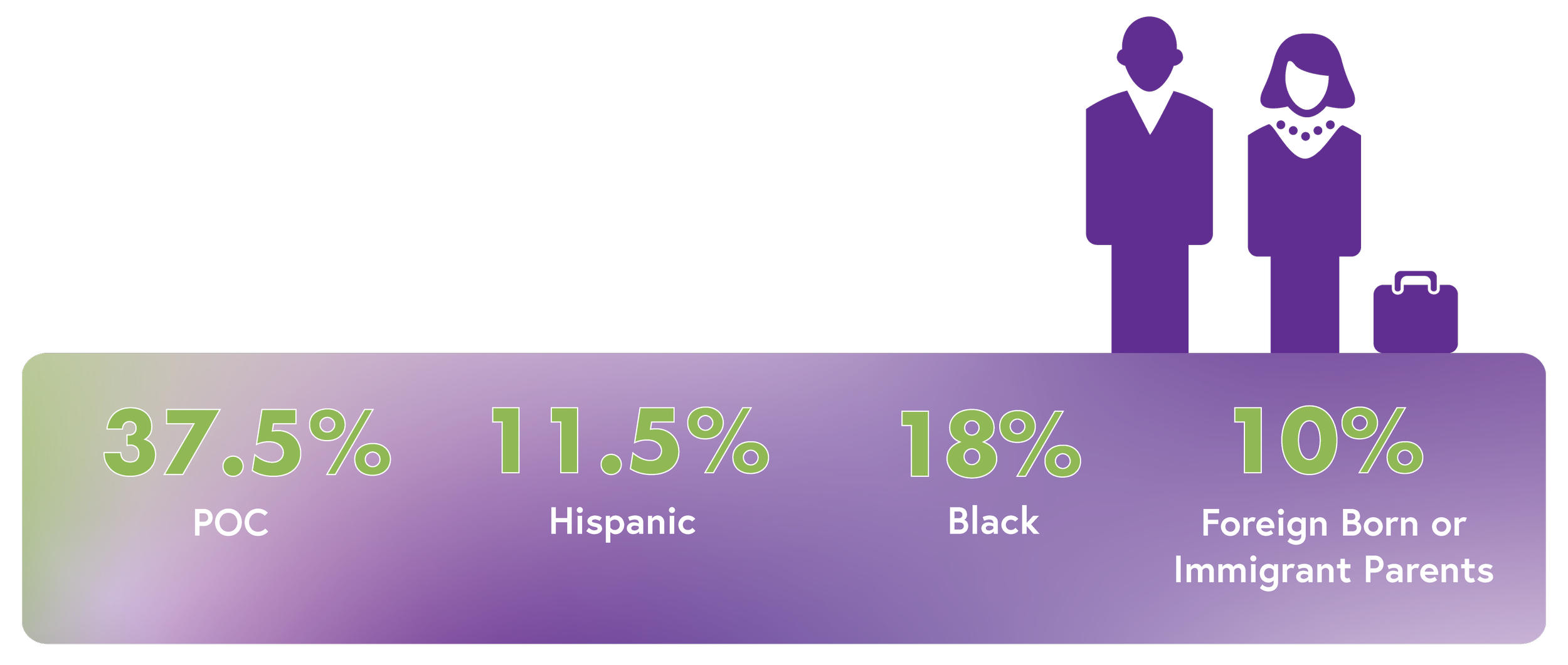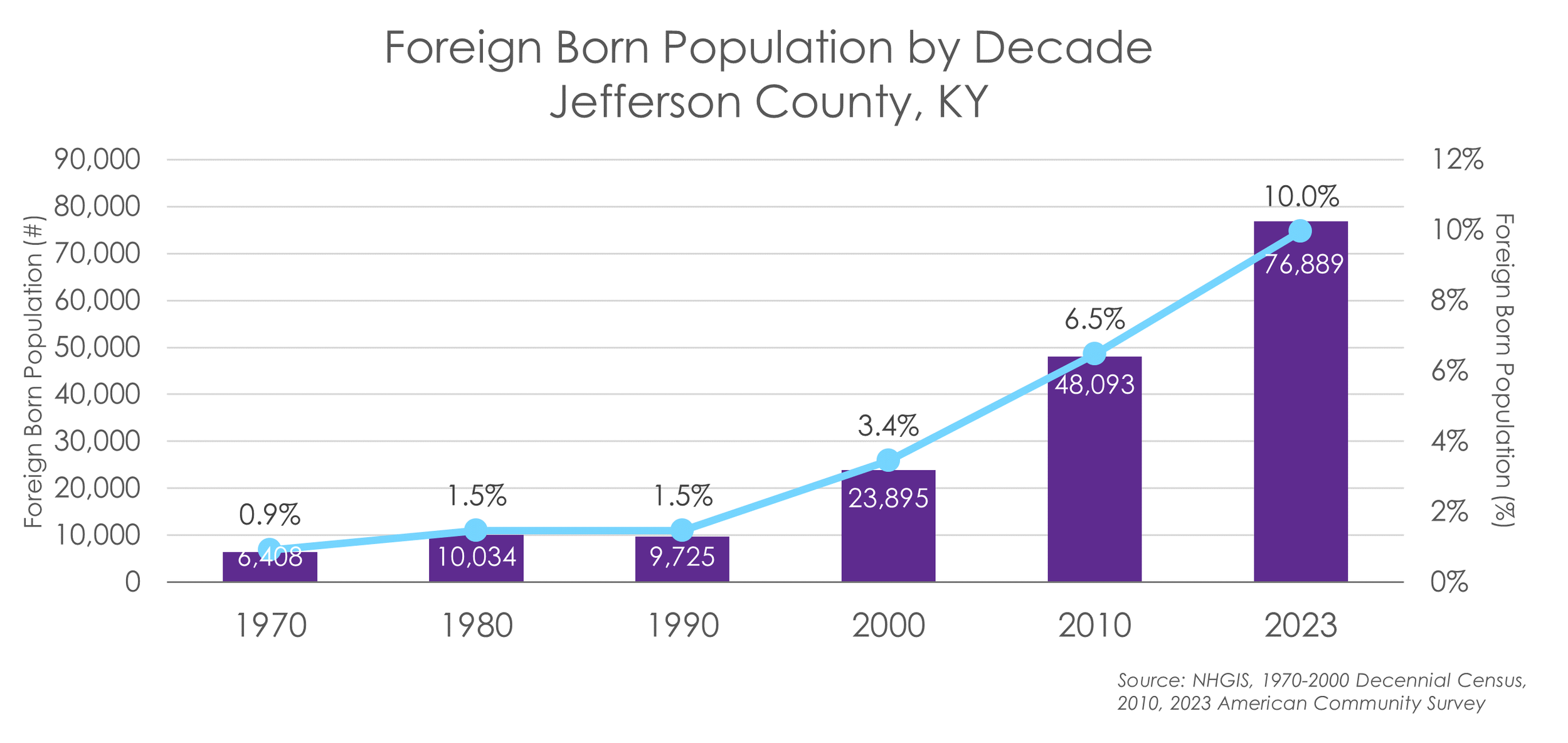
Employer Guide to Hiring & Retaining Foreign-Born Workers
Best Practices for Louisville, KY and Surrounding Counties
This guide provides employers with access to resources for fostering inclusive workplaces and leveraging the strengths of foreign-born talent in the Louisville region. Each workplace is different and we encourage you to put into practice the elements that best meet the needs of your organization and workforce to the mutual benefit of managers and frontline workers.
Introduction
The Louisville region’s population is 10% foreign born (NHGIS, 1970-2000 Decennial Census, 2010, 2023 American Community Survey). According to the National Fund for Workforce Solutions, the United States is undergoing an unprecedented generational change. During this demographic shift, we will see over 73 million individuals reach retirement age by 2030. This will have an enormous impact on the available workforce in our country. Simultaneously, the most diverse generations of young adults ever will enter the workforce. Nationally, 48% of Gen Z are People of Color (POC), 25% are Hispanic, and 14% areBlack). Locally, 37.5% of Gen Z are People of Color (POC), 11.5% are Hispanic, and are 18% Black**. The call from employers for an equipped labor force will be answered by a young, multi-racial, multi-ethnic, multi-generational workforce.
* The National Fund unites a dynamic network of regional workforce leaders who partner with us to test new ideas, learn from success and setbacks, and share what works with the field.
** Source: US Census Bureau, 2024 Population Estimates. “Gen Z” reflects people ages 29 and younger reflects 13-county Kentuckiana region.
The Economic & Cultural Benefits of Hiring Foreign-Born Workers
Foreign-born workers contribute to economic growth, fill critical labor shortages, bring multilingual capabilities, and enrich workplace culture with global perspectives. In purple boxes throughout this guide, you will find commentary collected from employers and foreign-born workers in a series of community roundtable discussions and focus groups in 2024-2025. Each worker perspective is followed by a Key Takeaway that points to related worksite practices that can support employee retention.
What are workers saying? Having a mentor helped me understand the workplace and feel confident in my new role.
Key Takeaway: Providing a positive relationship experience can lead to employee success and foster a deeper connection between the employee and the workplace.
Overview of Louisville’s Foreign-Born Workforce
Louisville’s foreign born population has grown considerably in recent decades.
What are workers saying?
We need a better understanding and promotion of how to search for jobs.
Transportation is a key factor when we are looking for jobs.
Being able to improve my English skills was crucial to advance in my workplace.
Key Takeaway: The barriers to obtaining initial employment are complicated and varied – from language issues to the practical necessity of vehicle ownership.
Legal Considerations & Compliance
Employment Eligibility Verification
Employers must complete Form I-9 for all hires and verify work authorization through acceptable documents. E-Verify use is optional in Kentucky but may be required for federal contractors.
Work Authorization & Visa Categories
Common statuses include lawful permanent residents (green card holders), refugees/asylees, and those on work visas (e.g., H-1B, H-2A/B, TPS holders).
ICE audit and Raid Preparation
Best practices for dealing with U.S. Immigration and Customs Enforcement (ICE) audits are in flux and the Employer’s Playbook For ICE Audits And Workplace Raids provides current legal advice.
Recruitment & Hiring Best Practices
Transparent Communications About the Hiring Process
Employers must avoid discrimination based on national origin or citizenship status and ensure fair hiring practices under Title VII and the Immigration and Nationality Act (INA). Transparent communications practices help foreign-born workers understand that they are being paid fairly and in compliance with federal and state wage laws, regardless of immigration status.
Developing Inclusive Job Descriptions
Use plain language and focus on essential skills. Avoid jargon or unnecessary credential requirements that may exclude qualified immigrants.
Connecting to Foreign-Born Talent
Advertise in media connected to immigrant and refugee communities, attend community job fairs, and post with local immigrant-serving organizations. See Resources for contact information.
Partnering with Local Immigrant Organizations & Workforce Development Agencies
Connect with groups like Catholic Charities, Kentucky Refugee Ministries, International Rescue Committee, Americana Community Center, Somali Community of Louisville, See Forward Ministries, Louisville Hispanic Chamber of Commerce, and KentuckianaWorks for referrals and cultural insight.
Interviewing & Hiring Considerations
Evaluate core skills and potential: Look beyond a candidate’s interview performance. Focus on their potential to learn, grow, and contribute to the team, rather than on their "polish."
Recognize and challenge your own biases: Take the time to reflect on what you might be looking for in a candidate. Are you drawn to someone who reminds you of yourself or who communicates in a way you find familiar? Actively challenging these biases will help you make more objective hiring decisions.
Consider that many foreign-born workers raised outside of the United States may have communications styles that differ from conventional expectations. In some cultures, it may be considered rude to make direct eye contact with an authority figure. In others, a candidate might be taught to be more reserved about their accomplishments rather than "boast."
What are Manufacturing Employers saying?
Pay for a translator for performance reviews.
Remind managers that understanding and speaking a language are two very different skills and that often the foreign-born employees understand a lot more than one would think. This helps avoid limiting non-English speakers to those departments where we know that our existing employees can help interpret and onboard.
Onboarding & Workplace Integration
Based on conversations with employers of foreign-born workers in our region.
Recommendations for Creating a Welcoming Workplace Culture
Celebrate cultural diversity, offering inclusive signage and materials, and promoting equity from day one.
Introduce stay interviews: Conduct candid conversations about an employee’s current reality and, include specific questions about their experience as a foreign-born worker and any unique challenges they may face in order to understand what makes them want to stay at the company, identify areas for improvement, and foster loyalty.
Spend more time with new hires: Dedicate more time to new employees during their onboarding process, providing extra support and resources for foreign-born workers who may be navigating a new culture and work environment.
Plan out the first 6 weeks for new hires: Create a structured plan for the initial weeks of a new employee's tenure, incorporating specific modules or support systems tailored to the needs of foreign-born workers, such as language assistance or cultural orientation.
Discuss advancement upfront: Discuss career advancement opportunities with new hires early in their employment, clearly explaining career paths and expectations in a way that is culturally sensitive and easy for foreign-born workers to understand.
Introduce new hires to key people: Ensure new employees meet important colleagues, including upper management, specifically connecting foreign-born workers with buddies who can help them acclimate to the workplace and local culture.
Set up onboarding checklists with checkpoints: Create checklists with milestones for Day 1, Week 1, Month 1, and Quarter 1, including specific checkpoints to address the unique needs and potential challenges of foreign-born workers during their initial months.
Implement trauma-informed policies and practices: These approaches can prevent harm, build resilience, and promote healing, engagement, and empowerment, ultimately increasing safety, health, well-being, productivity, and commitment to the organization, while also being mindful of potential past traumas or challenges foreign-born workers may have experienced.
Orientation & Training Adjustments
Use visual aids, slower-paced delivery, and hands-on learning where possible.
Pre-orientation and orientation in employee’s preferred language: Conduct sessions in the employee's preferred language to ensure full comprehension of company policies, benefits, and workplace norms.
Cross-functional support from mentors: Pair new foreign-born employees with existing staff members who can provide guidance and support in acclimating to the workplace and culture.
Key document translation: Translate important benefits, training, and safety documents into multiple languages to ensure all employees have access to critical information.
On-demand phone interpretation support: Provide readily available phone interpretation services for immediate communication needs where allowable.
"Pre-orientation" focusing on benefits and healthcare: Offer a separate session specifically designed to explain U.S. healthcare and insurance systems, allowing new employees to process complex information and ask questions before the general orientation.
Benefits of Assigning Mentors or Workplace Ambassadors
Pair new hires with peer mentors to foster connection, answer questions, and build trust.
Bridge the gap between skills and job opportunities: Mentoring programs can help foreign-born workers align their existing skills and experiences with available job opportunities in their new country.
Expand their network: Mentors can introduce foreign-born workers to key people and help them build valuable professional networks.
Gain insights into U.S. workplace culture and industry trends: Mentors can provide guidance on navigating a new cultural and professional environment, including understanding workplace norms and industry specifics.
Achieve career goals: Through personalized support and guidance, mentors can help foreign-born workers set and achieve their career aspirations.
Boost confidence: Mentoring has been shown to significantly increase the confidence of participants, empowering foreign-born workers to believe in their experience and skills.
Improve communication and language skills: In virtual mentoring settings, the emphasis on written communication can help strengthen an employee's ability to write in a foreign language.
Providing Language & Communication Support
Offer English for Speakers of Other Languages (ESOL) classes, multi-lingual signage, and encourage the use of translation tools or services when appropriate.
Be aware that using jargon and colloquialisms might lead to misunderstandings e.g. fixing to leave, pass away, what's up, etc.
Provide cultural orientation to the new employee and to the established workforce at the company.
Greetings: Keep in mind that cultural norms differ when it comes to physical and eye contact.
Use inclusive language: Asian vs. Oriental, Undocumented Immigrant vs. Illegal Immigrant. etc.
Post notices in the language of the employees. Ideally, in English and the other language side by side.
Train supervisors and staff by providing classes to learn basic vocabulary in another language.
What are Financial Sector Employers saying? The participation in the support groups that emphasize personal relationships are a key part of the retention at the bank.
Retention & Career Advancement
Addressing Workplace Bias & Fostering Inclusion
Implement cultural humility training, anti-bias training, and establish clear reporting systems for discrimination or harassment.
Professional Development & Upskilling Opportunities
Support access to training, apprenticeships, and leadership development tailored to immigrant employees by providing time and space. This readies staff for opportunities for advancement.
Pathways to Promotion
Recognize and utilize employees’ past experiences, educational levels, and skills to create a path for internal advancement and professional growth.
Supporting Work-Life Balance
Consider offering flexible scheduling to accommodate cultural and religious observances.
Consider more aspects of job quality with the National Fund for Workforce Solutions Job Design Framework.
What are Healthcare Employers saying?
Tools like Google Translate are illegal in a healthcare setting due to privacy concerns (not HIPAA compliant).
Provide a dollar an hour raise for gaining competence in two languages.
Provide onsite ESL courses.
Recognize cultural differences: we have noted that in conversation with the supervisor the employee may say everything is fine; in follow-up conversation with the staff social worker they may note many issues.
What are Hospitality Employers saying?
To foster a successful and supportive work environment, it's a great practice to have a manager, supervisor, or key team member who can communicate in the same language as your frontline hires. This has a direct and positive impact, making new employees feel more comfortable and ensuring that important information and instructions are understood clearly.
Community Engagement & Resources
Providing holistic supports can more fully integrate the new hire into the community and allow them to be more poised for success on the job.
Connecting Employees with Local Resources
Guide workers toward housing support, English as a Second Language (ESL) programs, legal aid, and adult education providers.
Employer Support Networks
Join employer coalitions or peer groups to share strategies, challenges, and resources. Mike Karman at KentuckianaWorks can assist in convening employer coalitions to brainstorm best practices and challenges. Edgardo Mansilla can connect employers with ESL training and related resources.
Encouraging Civic Engagement
Promoting awareness of naturalization options, voter registration (for eligible employees), and local volunteer opportunities increases feelings of belonging, which has positive implications for employment retention.
What a manufacturing employer says: One of our proudest success stories involves a foreign-born employee who began his journey with us as an apprentice. Despite the challenges of adapting to a new country and language, his strong work ethic, commitment to learning, and leadership potential quickly stood out. Over the course of three years, he progressed from apprentice to job foreman, and was later promoted to project manager. Today, he not only leads complex projects with confidence but also serves as a source of inspiration and motivation to other immigrants within the company.
Resources
Sample Policies & Templates
List of Local and National Resources
Urban Institute: Bringing Evidence to the Refugee Integration Debate
Continue to provide us with feedback!
Would you like to join periodic group discussions with other employers, community partners and educators to discuss best practices? Please send a message to Mike Karman or Edgardo Mansilla.








